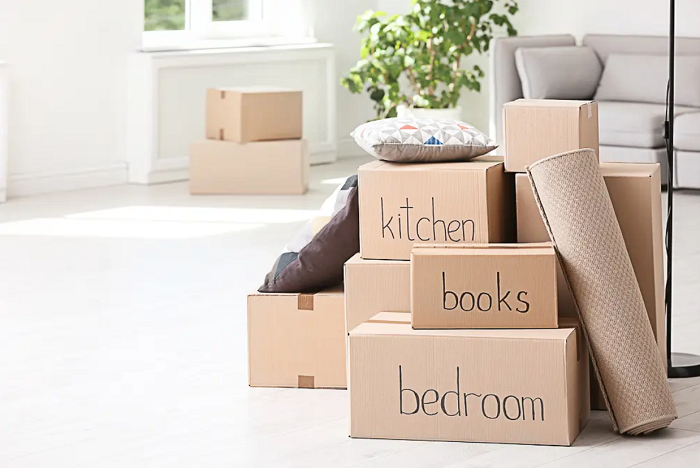We heard that you are planning to move to a new space! Moving has always been a big deal in anybody’s life, here we provide you The Top 9 Tips For Planning A House Move so that your trip can be a chilling one.
First of all, do you consider yourself a free spirit who lives by the whims of the moment?
Or would it be more accurate to describe you as a cautious person who prefers to plan things out in advance?
Nobody is looking forward to unanticipated setbacks, problems, and barriers on your road. That’s exactly what will happen if you don’t plan thoroughly and thoroughly before embarking on a major activity — a study project, a business venture, a house relocation, etc. – in the first place. But how do you plan a project of this scope?
The helpful advice below will help you organize every part of your move in the most effective manner possible and construct the optimal moving strategy for your future transfer.
1. How to Plan a House Move – Top 9 Tips For Planning A House Move
It’s easy to equate organizing a house move to putting together a large, difficult jigsaw puzzle. To complete the puzzle successfully, you must place all the pieces together in the correct order. If you leave out a piece of the puzzle or put it in the wrong spot, you won’t be able to complete the image. Moving preparations will never be completed on time and a trouble-free move will never be possible if a stage in the relocation plan is missed or scheduled incorrectly.
2. When to Start Planning a Move – Top Tips For Planning A House Move
To move, you’ll need to come up with a moving schedule. Do you have enough time to think through every part of the complicated relocation procedure before you begin to plan your move?
It’s preferable to begin arranging your move as soon as possible, but it might take anything from a month to a year depending on a variety of factors.

- Distance of relocation – The more difficult it will be to relocate, the earlier you should begin planning your relocation strategy;
- Move size – It will take longer to prepare a large family to relocate, so you should begin preparing your move well in advance if your family is large.
- Time of your move – plan if you’re planning a move during peak season (May to September) when moving services are at their busiest and it will be difficult to find trustworthy movers who can meet all of your needs and preferences.
Bonus tip: Having enough money to cover all moving expenditures is essential if you want to be financially secure throughout your upcoming move. Starting your relocation savings a year or so in advance can ensure that you’ll have adequate money available when the time comes to implement your relocation plan.
To begin your relocation preparations, you must first understand when and how to begin arranging a move.
3. What to Do First When Making Relocation Plans
To begin the process of moving house, you must first conduct research and make many key decisions:
Explore your new neighborhood

Consider the advantages and drawbacks of relocating to a new city before making the decision.
As a result, familiarize yourself with your new surroundings and learn how to effectively prepare for your new life:
- Even if you’ve already landed a job, it’s a good idea to familiarize yourself with the job market, career chances, and employment options in your new location.
- Find out how much it will cost you to live in your new neighborhood so that you can budget for things like food, transportation, utilities, health care, and other requirements after you move there.
- To ensure that your paperwork is in order, familiarize yourself with the local rules and regulations.
- Research the social norms and customs in your new community to better prepare yourself for living in a new place.
- It’s important to know what to expect from the weather in your new location, as it will decide the type of clothing you’ll need as well as your health and safety, and it may even necessitate particular safeguards.
- Learn about local healthcare, education, entertainment, and cultural activities before moving to a new location.
If you’re planning to stay in your current city and just move to a new house, you won’t notice much of a change in your daily routine or surroundings. Your new neighborhood and a suitable home are all that’s required of you to get settled in.
Find a nice home to live
The process of finding a new house for you and your family may be difficult when moving to a new city. When moving to a new location, it is extremely recommended that you do extensive research on your housing options before you arrive.
The process of moving will be much easier if you find a place that meets your needs and preferences in terms of size, home features (such as a floor plan), location, price, etc. You’ll know exactly where you’re moving to, and you’ll be able to take your belongings directly to your new home (so you don’t need storage).

Before making a long-term commitment, it’s a good idea to rent a short-term apartment or house to familiarize yourself with the region and its specifics (such as the crime rate and the availability of local amenities) so that you can make an informed decision about where to settle down. Having to move twice in a short amount of time, find a location to put the household things you can’t take with you into temporary housing, and so on will make the transition even more difficult.
Just make sure you pick a good area and take advantage of the short distance to make your move as easy as possible when you’re moving across town to discover the right new house for you and your family. Some helpful advice on moving to a new neighborhood can be found here.
4. How to Get Things Started When You’re Moving
Moving out is the next step after you’ve done all the research you need to do.
Decide on a moving date

Which time of year is the most ideal for a house move? Is it better to wait until the conclusion of the school year or the beginning of a new job to move? This depends on your unique situation and some crucial seasonal considerations (such as the start and end of the school year) (weather conditions, traffic conditions, and personal engagements differ in different seasons and so do moving rates). If you’re picking a relocation date, keep in mind these considerations:
- It will cost you more to move during peak season (from May to September) than it will move at a less busy time of year. Because moving services are in high demand and good movers are already booked months in advance during the summer months, it will be more difficult to find a trustworthy moving company.
- A weekday relocation will cost less but you’ll have to take time off from work and friends and family won’t be able to help you move because they won’t be available.
- A holiday move has the same drawbacks as one during peak moving season.
Bonus tip: As soon as you know the date and time of your relocation, begin searching for movers and reserve the services of your preferred moving company at least four to eight weeks in advance.
A moving calendar can help you keep track of how much time you have left till the big day, and it can also serve as a reminder of how far you’ve come.
Setting a moving timeline
To put it another way, it’s a detailed checklist of everything that has to be done before the big day, including due dates for each item. Every mover’s needs are unique, so the tasks on the list should be ranked according to their importance, difficulty, and urgency.
Many people believe that a customized moving schedule is the ideal tool for organizing a relocation. It will not only help you keep track of things and arrange your time in the best possible way, but it will also allow you to reduce every huge relocation task into manageable mini-goals and focus on the ones at hand so that you don’t feel overwhelmed by the size of the moving process. All it takes is a glance at your moving calendar to establish clear objectives for the day and avoid forgetting anything vital.
It’s important to make sure that you have enough money to pay all of the expenditures associated with moving.
Create a moving budget

It’s impossible to plan a successful move without taking into account the costs associated with moving. Determine what you can afford in terms of moving aid and post-relocation costs by putting together a moving budget. You’ll know exactly how much money you’ll need for each part of the relocation process, and you’ll be able to respond immediately if a moving activity surpasses its budgetary limit.
Moving materials, moving services, transport charges, insurance prices, post-relocation fees, and contingency expenses all need to be factored into your moving budget while you’re planning your move.
Having a moving budget that is both realistic and efficient will reduce the financial risks you face during your relocation. When moving to a new good idea to make sure you have at least twice the amount of money you anticipate you’ll negotiate.
5. What to Do When Planning to Move

Your relocation plan is now complete, and you can begin making final preparations for the actual move:
Pare down your possessions

While it comes to deciding what to keep and what to get rid of when you’re downsizing, it’s important to keep in mind that many of your present goods don’t fall into either category and won’t be ideal for your dream home. As a result, moving all your belongings will be both expensive and difficult (moving costs are based on the weight of the shipment and the complexity of the job, which means that moving a large number of items will cost more money and take longer to complete).
Make a moving inventory

It’s time to prepare a moving inventory once you’ve decided which of your items to pack and which to leave behind. If you’re relocating, compile a complete inventory of the goods you’re taking with you and include all the necessary information about them, including its type, distinctive qualities (material, make or model number), approximate worth, and destination room (photos, warranties, quality certificates, appraisal statements, etc.).
Using an inventory list, you can get a better idea of the total cost of your move and keep track of your belongings as you go.
Ensure that moving assistance is available
Moving to a new location, whether it’s a new state or just a new neighborhood in your current city, is a huge undertaking that requires assistance.
Working with a professional moving company is your best bet, as they will have the necessary moving equipment, extensive experience, and professional know-how to handle your relocation the most safely and efficiently possible. If you want to get in touch with several reputable moving companies, request in-home estimates of your moving costs, compare the offers, research the movers that seem to best suit your needs, and choose the right relocation partner for you, you should fill out a moving quote.
For those who have the time and resources, renting a moving truck and driving yourself to the new location is also a viable option. For a self-move, it’s best if you have some reliable friends who can help you lift and carry your heavy furniture as you won’t be able to do it on your own.
Get appropriate packing supplies

Determine what kind of packing supplies and how many you’ll need to ship your items by going through your moving inventory. Packing supplies should be purchased well in advance so that you can begin the process as soon as possible:
- Buy new moving boxes, bubble wrap, packing paper, foam sheets, and other high-quality packaging materials for your most delicate and valuable items.
- Find free packing supplies, such as old cardboard boxes and bubble wrap, to save money on shipping costs;
- You can save money by not buying moving boxes and instead of using things you already have around the house to pack your things: old suitcases, bags, backpacks, baskets and buckets, shredded office paper and balls of yarn in place of packing peanuts, old clothes and towels in place of bubble wrap, regular blankets in place of moving blankets, and so on.
Avoid using old moving boxes and other non-specialized packing supplies, as they won’t protect your items as well, and take extra precautions when packing your possessions.
Pack your belongings
In the absence of hiring professional packers, you should begin packing your items as soon as possible to give yourself enough time to properly care for and protect them during transit:
- To save time and space (and a lot of nerves!), familiarize yourself with the golden rules of packing and look for some clever packing tricks.
- Find out what you can’t take with you when you move (items that aren’t allowed);
- The rooms and items you use the least should be packed first. (Our detailed packing timeline has more information on when to pack what for moving.)
- You’ll need a lot of time to pack storage areas, which are notoriously difficult to pack.
- Packing can be made much easier if you use a detailed room-by-room packing list.
- The safest and most efficient methods for packing different types of items should be used to ensure the safety of your belongings.
- Determine a labeling system that is both efficient and easy to read; write any necessary handling instructions in large, bold letters.
- For long-distance moves, pack an open-first box with the necessities you’ll need to get by for a few days without the rest of your belongings or the things you’ll need right away upon arrival (when moving locally).
When packing your belongings, avoid mistakes and make sure you have adequate moving insurance coverage.
Take care of the paperwork

A cross-country move necessitates a great deal of paperwork, which necessitates a great deal of patience and effort. A month or so before your move, you should begin gathering and updating all of the necessary paperwork.
- You should keep a file on everything from your medical history to your bank statements.
- Your mail will be forwarded to your new address by the time you get there, so make sure to update your USPS address a few weeks before you move.
- Notify everyone and everything of your relocation (friends and family, utility companies and other service providers, government agencies and financial institutions, etc.) and provide them with your new address;
- Your old home’s utilities should be disconnected the day after you move out, and your new homes should be running on the day you move in.
- Memberships and subscriptions can be canceled or transferred.
Make sure you have all the paperwork you need for your move, read it thoroughly, and don’t sign anything you don’t agree with (or any incomplete or blank documents).
Organize a smooth moving day

To ensure that your move goes as smoothly as possible on moving day, it is essential to have a well-thought-out moving day strategy in place. Every aspect of the move, including the weather, the traffic, the parking issues, the best way to handle your movers, the safety of your items, your property, and everyone involved, must be considered. You also need to plan for the food and beverages!
On moving day, you need to know what to expect and how to best prepare for it to keep everything running smoothly. A detailed moving day checklist can be found by clicking here to ensure a safe, smooth, and successful relocation on moving day.
6. Plan a Stress-Free Relocation

Even though it may seem difficult at first, the secret of a stress-free move lies in proper preparation and preparing for unexpected difficulties or rapidly changing circumstances. If you want a hassle-free move, you need to do the following things:
- Consider all of your options, look into all of your options, and gather as much information as possible before embarking on your relocation journey.
- Moving can be expensive, so it’s important to know how to save money. When planning a move, financial concerns are the most common cause of stress, as moving is a costly endeavor. There are many ways in which you can reduce moving costs and make your move more affordable to alleviate these concerns and avoid financial difficulties when moving.
- If you’re moving, learn how to cut down on the time it takes – Time is just as stressful as money when it comes to moving because there are so many things to do and not enough time to do them. There is no way around the fact that moving day is coming, but if you know how to make the most of the time you have until then, you’ll be ready to go when it does.
- The least that you can do is follow through on your moving plan if you put in the time and effort to do so. To ensure that your move goes as smoothly as possible, make sure that you follow a master moving checklist, pack efficiently, keep track of your belongings, and keep your focus at all times; this will ensure that your move goes as smoothly and efficiently as possible.
- Keeping your cool will allow you to think clearly and come up with an efficient solution to any problem or challenge that may arise during the moving process.
- Things should not be done hastily, so take your time and do not make hasty decisions or take hurried actions.
- To ensure that you haven’t missed, overlooked, or forgotten anything, do a thorough review of everything.
- Allow yourself to be adaptable and receptive to new ideas. Be prepared for the unexpected; have a backup plan.
- The best way to keep moving stress at bay is to keep your wits about you – a joke a day helps.
When moving to a new home is in your future, you’ll be prepared. Although each move is unique, no relocation situation is the same as the next one. As a result, once you’ve mastered the fundamentals of relocation planning, you should take a closer look at how to plan your specific type of move.
7. How to Plan a Local Move

Short-distance moves are easier to plan than long-distance moves, but you still need to make sure everything is in order.
- Knowing the area well will save you time and effort. You only need to look for a suitable new home, not do any extensive research.
- Your local move will still necessitate the creation of a moving calendar, a moving budget, and a moving inventory to keep it on schedule;
- You won’t have to update your driver’s license or car registration, cancel memberships, etc., making it easier to organize your paperwork. For example, if your new home is within a reasonable distance of a family doctor or school for your children, you may not even need to look for a new place to live or a new school for your children. Despite this, you will have to change your address and switch your utility providers;
- When moving, it’s always best to hire a professional moving company, but if you don’t have the time or inclination to do it yourself, your friends and family can assist you in loading and unloading your belongings. If you have enough time, you can rent a smaller moving truck or borrow a pick-up truck from a friend to make multiple trips between your old home and your new one, which will save you money.
- If you buy or rent a new place at least a week before moving out of your old one, you can overlap the periods available to you in both places. So that you can get your new home completely ready for moving in (renovated and thoroughly cleaned), as well as to bring some of your belongings with you to the new place before moving day, it will be much easier and quicker for you.
- With your car and any non-allowable, you wish to bring, moving to a new location will be much easier and less stressful than if you were moving across the country, shipping your vehicle, or planning a long road trip for yourself.
8. How to Plan a Long-Distance Move

Long-distance moving is a much more daunting task than moving across town or city. You must find a trustworthy long-distance moving company, make sure your belongings are safe during the long-distance journey, deal with a ton of paperwork, and plan your trip to your new home. Determine what you need to do before moving to a new state:
- Be prepared for a wide range of cultural and climatic differences when moving to a new place, so take the time to familiarize yourself with the area before you arrive.
- If you’re moving across the country, don’t even think about doing it on your own. Instead, look for reputable cross-country movers. To get the best value for your money, go with licensed and insured movers who have a proven track record and a solid reputation in the community. Moving scams and fraudulent attempts can be avoided by asking for recommendations, reading online reviews, getting in-house estimates from three or four reputable moving companies, finding out exactly what services are included in the offers and how much any required additional services are going to cost, comparing prices and conditions, and thoroughly researching the movers you intend hiring for your move.
- You can fly or drive to your new home, depending on your preference. Each approach has its benefits and drawbacks, so you should go with the one that best suits your needs.
Moving Your Pets Across The Country
- Make sure you’re aware of any pet-related laws and regulations in your new state.
- Go to the veterinarian for a complete checkup, get your pets’ records of their vaccinations, and get their health certificates;
- Shipping containers need to be chosen carefully;
- The best way to transport your pets is either by driving to your new home, shipping them by air, or using a pet transportation service. Decide which method is best for you and your pets (choose trustworthy pet movers who will keep your animal friends safe and comfortable along the way).
Organize your paperwork.
You’ll need to make changes and updates to a variety of documents, including your voter registration, vehicle registration, driver’s license, and insurance policies, among others. Transferring utilities and subscriptions, canceling memberships, retrieving medical and school files, etc., will also be on your to-do list.
Purge your possessions.
Decide what to do with non-allowable (because your movers won’t load them on the moving truck for safety reasons) and difficult-to-move items before the move (as the risk involved in their relocation is too big and moving them is not worth the cost). As much as possible, lighten the burden so that your long-distance move is less expensive and more convenient.
9. How to Plan a Move Abroad

When you move abroad, you’ll be immersed in a completely new culture, with a different way of life, a different language, and an entirely alien feel. Even if you’re moving to a completely new country, you’ll still have to adapt to the country’s unique cultural traditions, laws, social norms, daily practices, beliefs systems, and so forth.
Moving to another country can present many challenges, so you need a comprehensive moving strategy that will help you overcome these obstacles and ensure a successful start to your new life abroad:
- To prepare for your new life in your new country, do extensive research on the housing, employment, cost of living, safety, and cultural aspects of living there; contact your new country’s embassy and look for expatriate assistance to get inside information and reliable advice for your new life abroad.
- Make sure you have enough money to cover the costs of obtaining visas and other legal clearances, the cost of shipping your belongings overseas, the cost of traveling to your international destination, and your living expenses for the first few months in your new country;
- Take care of your health – Learn about the medical system in your new country and make an appointment with a doctor to ensure you have all the required vaccinations and medical documentation.
- It’s time to deal with the paperwork – There may be some time involved in getting all the necessary documents (passports, visas, work permits; insurance; certificates; license; financial records; property-related papers; medical reports; school records; references; etc.) updated or transferred. You should be aware of this and plan accordingly.
- Make sure your pets are covered – Check your new country’s live animal importation laws and specific regulations for moving pets and find out what papers you must bring for your animal friend(s) and if any additional immunizations are required. Your pets should be vaccinated, their medical records retrieved, and an international veterinary health certificate obtained before you travel with them. Determine if you’ll be flying with your pets or shipping them to your new location, and then make the necessary arrangements.
The Internet can help you plan and organize your move from beginning to end, regardless of whether you’re moving to a new city, state, or country.
>> Related Articles: TOP 10 WAYS THE FINAL MOVING COST CAN BE INCREASED
Conclusion
So, you’ve got your plans in place and you’ve completed the organizational phase of your move. Everything about your move has been thoroughly researched, analyzed, and contemplated. You’ve figured out the best way to get out of this situation. The time has come for you to put your plan into practice. Hope that the list of Top 9 Tips For Planning A House Move delivers helpful information and we wish the best of luck to you and may your plan succeed!
>> Related Articles: TOP 5 CREATIVE WAYS TO ANNOUNCE PEOPLE YOU ARE MOVING



